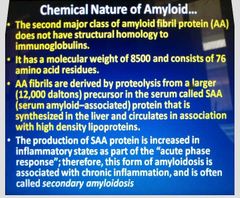![]()
![]()
![]()
Use LEFT and RIGHT arrow keys to navigate between flashcards;
Use UP and DOWN arrow keys to flip the card;
H to show hint;
A reads text to speech;
6 Cards in this Set
- Front
- Back
|
Physical nature of amyloid 1. On election microscope 🔬 2. On X-ray crystallography and infrared spectroscopy 3. |
1. On EM - amyloid is seen to be made up largely of continuous, non branching fibrils with a diameter of ~7.5 - 10 nm This EM structure is identical in all types of amyloidosis 2. On X-ray crystallography and infrared spectroscopy show a characteristic cross-β-pleated sheet conformation |
|
|
Amyloid material consist of ? |
Fibril proteins 95% remaining 5% p- component and other glycoproteins |
|
|
The major forms of amyloid List some minor forms |
1. AL amyloid 2. AA amyloid 3. Aβ amyloid
Minor 1. TTR - transthyretin - normal serum protein that binds and transports thyroxine and retinol 2. β2 - microglobulin - a component of MHC class I Molecules and a normal serum protein, has been identified as the amyloid Fibril subunit Aβ2m in amyloidosis that complicates the course of patients on long term haemodialysis 3. Prion proteins - CNS, local amyloidosis |
|
|
About AL protein 1. Is made up of? |
1. Complete immunoglobulin light chains, the amino-terminal fragments of light chains or both 2. Most are lamda chains or their fragments But in some cases kappa k - chains have been identified 3. The amyloid Fibril protein of the AL type is produced from Free If light chains secreted by a monoclonal population of plasma cells and it's deposition is associated with certain forms of plasma cells tumors |
|
|
About AA amyloid Fibril |

1. MW - 8500 , 2. 76 amino acid residues |
|
|
Serum amyloid o may contribute to amyloid deposition by? |
Stabilizing the fibrils and decreasing their clearance |

